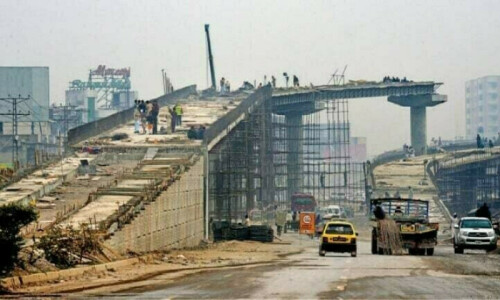DESPITE several rounds of talks, jirgas, meetings and agreements between Nato, Pakistan and Afghanistan over the past several years, strategic patterns paint a scenario of hostilities among the regional and international players involved in the conflict in Afghanistan and Pakistan.
It seems that the armed militant groups affiliated with Al Qaeda or those working independently mostly succeed in bringing about conflicts or widening chasms between states on various issues. The following events suggest that militant organisations have the upper hand when it comes to hard-core strategy-making.
Recently, the Afghan foreign minister complained at a UN Security Council meeting that some 4,000 people had been displaced from the eastern Afghan province of Kunar due to heavy artillery-pounding by Pakistani security agencies.
The Pakistani envoy to the US implicitly confirmed the complaint by saying that the Kunar province harboured TTP-affiliated organisations which continuously attacked the adjacent areas of Bajaur Agency and the settled district of Upper Dir inside Pakistan.
The envoy said the Pakistani side only chased the militants into Kunar. Pakistani authorities have already lodged several complaints with Nato and the Afghan authorities and wants them to help stop infiltration from Kunar and Nuristan.
The US Congress recently declared the Haqqani network a foreign terrorist organisation. This development implies that Nato and the International Security Assistance Force (Isaf) might have the ‘right’ to carry out pre-emptive strikes against the network, going by previous legislations of the US Congress and some resolutions adopted by the UN.
The 14-point resolution adopted by the National Assembly of Pakistan several months back, however, clearly states that infiltration inside Pakistan on any pretext by state or non-state actors would be tantamount to violating the sovereignty of Pakistan, besides indicating that Pakistani soil would not be used against any state.
It is reported that the Afghan National Army (ANA) has been withdrawn from participating in frontline combat alongside Nato forces after several sporadic events where Afghan army personnel apparently directed their guns at Nato personnel.
After analysing the above events one can easily understand three integrated patterns that do not bode well for peace and security in the region and the world at large.
First, the militant organisations active in Pakistan and Afghanistan and other countries in the region have succeeded in blocking understanding between Pakistan and Afghanistan on the one hand and among Nato, the Afghan government and Pakistan on the other.
Militants active in Kunar and Nuristan have not only successfully held Pakistani security agencies at bay, they have also succeeded in bringing Pakistan and Afghanistan to the brink of a low-profile conflict. It is the same strategy the militants used when they attacked Mumbai back in 2008 after which India and Pakistan were close to a war-like situation.
Keeping in view this pattern, one is not surprised at the claim of Afghan analysts that the sporadic events of the alleged Afghan National Army personnel attacking Nato personnel showed the strategic infiltration of Taliban in the ranks of the ANA. This pattern led to suspicions between the ANA and Nato forces which would certainly interfere with plans for the 2014 withdrawal.
Second, the objective of the militants’ strategies is clear from the very tactics they employ. It is to keep both Afghanistan and Pakistan destabilised and to make it difficult for Nato and Isaf forces in Afghanistan to come to any settlement in which the militants do not have an overwhelming share of power.
Compared to the militants’ ways, the strategies adopted by states in the region have multifarious ambiguities and contradictions making it difficult for them and others in the international community to develop consensus on a plan of action. For instance, both the Afghan and Pakistani governments complain about each other regarding infiltration across their borders, but both appear helpless when it comes to resolving the issue on their own. This leads to a vicious circle of blame and counter-blame which benefits militant groups in the two countries.
Until the Afghan and Pakistani governments reach an understanding, the matter of infiltration might not be resolved. And an understanding can’t be reached until the infiltration is stopped on both sides. For this to happen, both governments and civil society in the two countries must rise above the misperceptions created by vested interests. Hard thinking and planning is needed by both sides.
Third, militant organisations in Pakistan and Afghanistan have proved themselves adept in exploiting the vulnerabilities of regional states and societies to their advantage. They have put states in the region on the back foot on several issues and have strengthened their discourse of violence, while the states themselves have not been able to develop a counter-narrative.
At the societal level, the militant organisations have succeeded in positing political, sectarian and religious diversity as a threat to societies — in effect making plurality the basis of divisions. Large segments of populations in regional states have started believing in the discourse of brute force. They have also started believing that realities should not be viewed from diverse angles. Moreover, the militant organisations have also succeeded in painting Muslims around the world as a homogenised, single entity which in turn has created hostilities among people adhering to different beliefs. This again is a vicious circle.
People living in different parts of the world are then led to believe that ‘violence’ is the core of the Islamic faith. Some around the globe react to the notion and hence there is a violent reaction to it and the vicious circle continues.
Convergence of interests among regional and international states, actively promoting the discourse of non-violence and rethinking strategic policies are keys to finding the solution to active militancy in the region.
The writer is a socio-political analyst.











































Dear visitor, the comments section is undergoing an overhaul and will return soon.